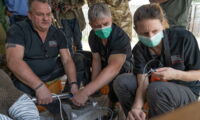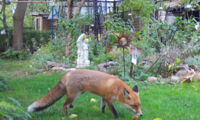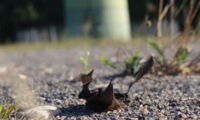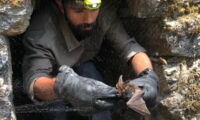The Leibniz-IZW regular publishes press releases on key findings and insights from its research and on events, awards or personalia. The press releases are distributed directly to journalists on our press release distribution mailing list. Press releases are also disseminated through the distribution services Informationsdienst Wissenschaft, AlphaGalileo and EurekAlert. Are you interested in receiving our press releases directly via e-mail? In this case please send us an email to presse@izw-berlin.de.
Current press releases

BioRescue creates two new embryos in race against time to prevent the extinction of the northern white rhinoceros
In two sets of procedures between October 2021 and February 2022 the BioRescue consortium created two new northern white embryos, bringing the total to 14. Oocytes (egg cells) were collected from northern white rhino Fatu in October and January at Ol Pejeta Conservancy, Kenya, and were matured and inseminated at Avantea laboratory, Italy. The developed embryos were cryopreserved in November 2021 and February 2022, and await transfer to southern white rhino female surrogates in the foreseeable future.

Progress in reproductive biology - new insights into the binding behaviour of the porcine sperm protein 'AWN'
A scientific team from the Leibniz Institute for Zoo and Wildlife Research (Leibniz-IZW), Humboldt-Universität zu Berlin (HUB) and the Leibniz Research Institute for Molecular Pharmacology (Leibniz-FMP) discovered a previously unknown localisation of the porcine sperm protein 'AWN', strengthening the assumption that this protein is involved in sperm-egg fusion. The new findings are important for assisted reproduction. The results were published in the journal "Biology of Reproduction".

Sequencing the world’s biodiversity: “Earth BioGenome Project” enters new phase in cataloguing the DNA of 1.8 million species
Sequencing the genomes of all plants, animals, fungi and other microbial life on Earth is a strategy to foster better understanding, management and restoration of biodiversity and ecosystem services. The Leibniz Institute for Zoo and Wildlife Research (Leibniz-IZW) and scientists working on the European Reference Genome Atlas (ERGA) work hand in hand with the Earth BioGenome Project (EBP) on this mission – building a global network of scientists as well as strengthening sequencing expertise and capacity. The EBP is now entering a new phase as it moves from pilot projects to full scale “production” sequencing. This new phase is marked with a collection of papers published this week in the “Proceedings of the National Academy of Sciences of the USA” (PNAS), describing the project’s goals, achievements to date and next steps.

Citizen science data from Berlin show that urban areas can be a refuge for bats, if certain conditions are met
Urbanisation is a notable threat to bat populations all over the world, especially through artificial light and the reduction of habitat and food supply. If certain conditions are met, some spaces within metropolitan areas can be suitable for bats, so managing these spaces appropriately could contribute to bat conservation. With the help of more than 200 citizen scientists in Berlin, a team of scientists from the Leibniz Institute for Zoo and Wildlife Research (Leibniz-IZW) examined these conditions and investigated how they affect the abundance and distribution of bat species. They conclude that maintaining a low level of artificial light at night is important for all bats in cities. In addition, access to vegetation and water bodies is essential for many of them. The results and conclusions are published in the scientific journal “Environmental Pollution”.

Wildlife cameras show how foxes, racoons, stone martens and domestic cats get along in Berlin before and during Covid lockdowns
Avoid or compete, eat or be eaten, exploit or cooperate – biotic communities are shaped by species interactions in many different ways. Urban environments represent a special case as human presence and influence may have fundamentally changed the rules of the game. Around 150 wildlife cameras installed by Berlin citizen scientists in their gardens in five rounds from autumn 2018 to autumn 2020 produced tens of thousands of photographs. Their analysis by a team of scientists from the Leibniz Institute for Zoo and Wildlife Research (Leibniz-IZW) sheds light on how foxes, racoons, martens and cats get along with people and with each other in the city: All three wild species used the same localities, but with little temporal overlap during the night. All wild species avoided domestic cats. And during lockdowns they were more often recorded, especially at night. These and more insights are published in a recent article in the “Journal of Animal Ecology”.

Wind turbines kill mostly female and juvenile bats
Many bats die at wind turbines when colliding with the spinning blades. Currently it is unclear whether all age cohorts or sexes are equally vulnerable. A comparison of age, sex and geographic origin of Nathusius’ pipistrelles killed at wind turbines and living conspecifics from nearby populations now reveals that juveniles are killed more frequently than adults compared to their proportion in local populations. Females are killed more frequently than males – yet in line with their higher proportion in local populations. The high number of killed females and the elevated vulnerability of juveniles may have a negative effect on the long-term survival of populations, indicating that the current practice of wind energy production may not be ecologically sustainable. The investigation was led by scientists from the Leibniz Institute for Zoo and Wildlife Research (Leibniz-IZW) and is published in the scientific journal “Ecological Applications”.
Read more … Wind turbines kill mostly female and juvenile bats

Forschungsverbund Berlin with new Managing Director
Dr. Nicole Münnich takes on the role of Managing Director of the Forschungsverbund Berlin e.V. (FVB) on December 1, 2021. She succeeds Dr. Falk Fabich, who was Acting Managing Director from April 2021 following the departure of long-time Managing Director Dr. Manuela Urban.
Read more … Forschungsverbund Berlin with new Managing Director

Himalayan bats are functionally less diverse at high than at lower elevations, but show the same evolutionary diversity
Million years of evolution have produced a dazzling variety of species, each uniquely adapted to its environment. A straightforward way to measuring biodiversity is by the number of species (taxonomic diversity). Recently, there is growing emphasis to quantify diversity also in other ways: a) functional diversity, which is the diversity of phenotypic traits that allow organisms to perform their ecological functions and b) phylogenetic diversity, meaning the variation in the branches in the tree of life. In a paper published recently in the journal “Scientific Reports” a team of scientists led by the Leibniz Institute for Zoo and Wildlife Research (Leibniz-IZW) compares these approaches: They found that species richness and functional diversity of Himalayan bat communities decline at high elevation without the loss of phylogenetic diversity. Their findings provide insights on the diversity of bats in the Himalayas and serve as an important baseline in assessing this diversity in the context of environmental changes.

